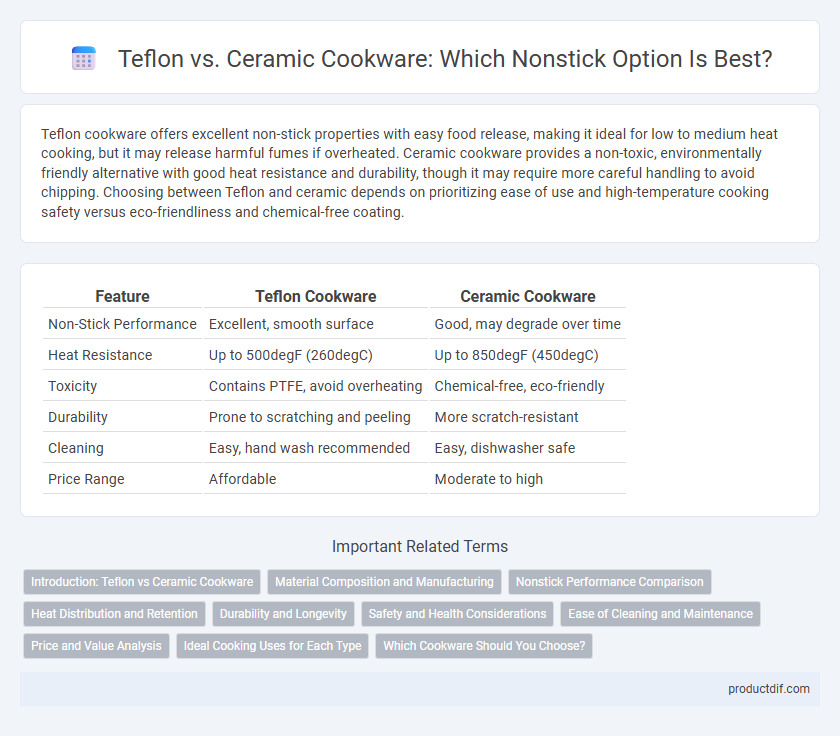Teflon cookware offers excellent non-stick properties with easy food release, making it ideal for low to medium heat cooking, but it may release harmful fumes if overheated. Ceramic cookware provides a non-toxic, environmentally friendly alternative with good heat resistance and durability, though it may require more careful handling to avoid chipping. Choosing between Teflon and ceramic depends on prioritizing ease of use and high-temperature cooking safety versus eco-friendliness and chemical-free coating.
Table of Comparison
| Feature | Teflon Cookware | Ceramic Cookware |
|---|---|---|
| Non-Stick Performance | Excellent, smooth surface | Good, may degrade over time |
| Heat Resistance | Up to 500degF (260degC) | Up to 850degF (450degC) |
| Toxicity | Contains PTFE, avoid overheating | Chemical-free, eco-friendly |
| Durability | Prone to scratching and peeling | More scratch-resistant |
| Cleaning | Easy, hand wash recommended | Easy, dishwasher safe |
| Price Range | Affordable | Moderate to high |
Introduction: Teflon vs Ceramic Cookware
Teflon cookware features a non-stick polytetrafluoroethylene (PTFE) coating known for its ease of food release and low-fat cooking benefits. Ceramic cookware offers a non-stick surface made from inorganic minerals, providing a chemical-free alternative that withstands higher cooking temperatures. Both types cater to different cooking needs, with Teflon excelling in convenience and ceramic emphasizing natural, eco-friendly performance.
Material Composition and Manufacturing
Teflon cookware features a synthetic polymer called polytetrafluoroethylene (PTFE) known for its non-stick properties and high chemical resistance, produced through a polymerization process that creates a durable coating. Ceramic cookware consists of a metal base coated with a silica-based ceramic layer, formed by a sol-gel process that involves high-temperature curing to enhance hardness and non-stick performance. The manufacturing of Teflon relies on complex chemical treatments ensuring a smooth, non-reactive surface, while ceramic coatings emphasize natural mineral components and environmental-friendly production techniques.
Nonstick Performance Comparison
Teflon cookware offers superior nonstick performance with its polytetrafluoroethylene (PTFE) coating, allowing effortless food release and easy cleanup even at lower temperatures. Ceramic cookware provides a non-toxic, PTFE-free nonstick surface, but its effectiveness often decreases faster due to coating wear and lower heat resistance. Consumers seeking long-lasting nonstick reliability tend to prefer Teflon, while ceramic appeals to those prioritizing chemical-free materials despite potentially reduced nonstick longevity.
Heat Distribution and Retention
Teflon cookware offers excellent heat distribution due to its non-stick coating but tends to have lower heat retention compared to ceramic. Ceramic cookware provides superior heat retention by evenly holding temperature longer, making it ideal for slow cooking and simmering. The choice between Teflon and ceramic largely depends on whether quick heat responsiveness or sustained heat is more critical for your cooking needs.
Durability and Longevity
Teflon cookware typically offers moderate durability, with non-stick coatings prone to scratching and wearing off after 2 to 5 years of regular use. Ceramic cookware provides enhanced longevity by utilizing a harder, more resilient surface that resists high temperatures and abrasion, often lasting 5 to 10 years with proper care. Choosing ceramic over Teflon can significantly extend the lifespan of non-stick cookware, making it a more durable option for long-term kitchen use.
Safety and Health Considerations
Teflon cookware contains polytetrafluoroethylene (PTFE), which can release toxic fumes at temperatures above 500degF, posing risks such as polymer fume fever. Ceramic cookware is generally considered safer since it is free from PTFE and perfluorooctanoic acid (PFOA), minimizing chemical exposure during cooking. However, ceramic coatings can degrade over time, potentially releasing nanoparticles, so proper care and timely replacement are important for maintaining health safety standards.
Ease of Cleaning and Maintenance
Teflon cookware offers superior ease of cleaning due to its non-stick surface, allowing food residues to wipe off effortlessly with minimal scrubbing. Ceramic cookware requires more careful maintenance, as its coating can degrade if harsh abrasives or metal utensils are used during cleaning. Regular gentle washing preserves ceramic's durability, while Teflon's smooth surface typically requires less attention to maintain its non-stick properties.
Price and Value Analysis
Teflon cookware generally offers a lower upfront cost compared to ceramic options, making it attractive for budget-conscious cooks seeking non-stick performance. Ceramic cookware provides enhanced durability and chemical-free cooking surfaces, often justifying its higher price through long-term value and health considerations. Consumers balancing price and value tend to favor ceramic for safer, more sustainable use despite the premium cost.
Ideal Cooking Uses for Each Type
Teflon cookware excels in low to medium-heat cooking, making it ideal for frying eggs, pancakes, and delicate fish due to its superior non-stick properties and easy cleanup. Ceramic cookware withstands higher temperatures, making it suitable for searing, sauteing, and oven use, providing excellent heat retention and even distribution. Choosing between Teflon and ceramic depends on the cooking method and desired temperature range for optimal performance.
Which Cookware Should You Choose?
Choosing between Teflon and ceramic cookware depends on your cooking needs and health preferences. Teflon cookware offers excellent non-stick performance and easy cleanup but may release harmful fumes if overheated, whereas ceramic cookware provides a more natural, chemical-free non-stick surface that withstands higher temperatures without toxicity. Consider durability, heat tolerance, and maintenance when selecting cookware for safe and efficient cooking.
Teflon vs Ceramic Infographic

 productdif.com
productdif.com